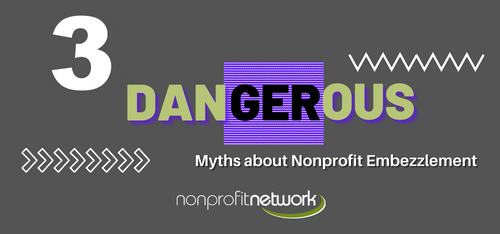

Tom Williams
Consultant
Typically, I like to use this blog space to share eye-opening ideas and tools to build your organization’s capacity so that more good is done in your community. But today I am compelled to step away from that and reflect on the ugly side of nonprofit life that ties my stomach in knots: embezzlement. Please, let me be clear: I am driven to share this, not for any sense of sensationalism, but rather because if you are aware and informed, you will be better prepared to prevent, detect, and recover any losses in the event that your organization is victimized in an embezzlement scheme.
It feels ugly to put it in writing, and feels so foreign because most of our energies in governing or operating nonprofits are spent on enhancements--on using charitable contributions appropriately and innovatively to impact positive progress on our mission. But there are three dangerous myths out there, and I want to address them today and offer some preventative measures to help dispel each myth.
3 Dangerous Myths about Nonprofit Embezzlement
1) "It hardly ever happens to nonprofits."
Anecdotally, I can share the horror stories of respected organizations losing funds from a greedy treasurer or an executive with a gambling problem, but while those stories are sad, they do not adequately capture the scale of the issue. The 2021 Michigan's Crime At A Glance report states that embezzlement was reported over 1,600 times. And while those were not all from nonprofit organizations, past reports illustrate that nonprofit organizations are the third (out of 15) most frequent industries to experience theft in this way.
Preventative measures:
- Actively seek ways to be more educated on the issue
- Create awareness among your peer leaders and have the necessary critical conversations (we can help).
2) "Everyone who works here is really a good person."
While embezzlement is certainly not exclusive to nonprofits, past reports make an interesting point about their data that ranks nonprofits as third out of 15 in embezzlement frequency: "This may not be an accurate reflection of the severity of this issue, since nonprofits have a reputation for not reporting fraud incidents in an effort to avoid negative publicity. The nonprofit sector, known for serving the public good, is more susceptible to fraud than many for-profit enterprises. This can be attributed to the unusual level of trust afforded to employees, founders, executive directors, or substantial contributors, along with weak financial controls.”
Preventative measures:
- Inform employees and volunteers about your policies so they know appropriate procedures, how to navigate the whistleblower process, and what the consequence are for theft.
- Follow through: If caught, prosecute, civilly and criminally.
3) "We don't have enough staff to have financial controls."
According to the Association of Certified Fraud Examiners, the median duration of a fraud (from beginning to detection) in 2019 was 18 months; and losses continued to grow as the duration of the scheme increased. In the cases when a scheme lasts five or more years, the median loss is $850,000. Think about the fact that there are nonprofits who are are currently victims of embezzlement as you read this but, but they won't know it for years. While embezzlement may cost an organization critical money, the real casualty lies in the damaged reputation. A single incident of fraud can impact your current support and future giving for years to come. If the public’s trust is broken, it’s a long uphill journey to restoration, and your reputation may never be repaired.
Preventative measures:
- If you are an organization with few or even zero employees be intentional on how you can incorporate volunteers into the separation of duties.
- Build the controls now to protect your reputation and assets--size of organization is relevant.
- Implement measures to minimize risk and help you detect theft quickly.
- Maintain adequate employee crime or dishonesty insurance to cover your losses.
Stumped on how to introduce such a challenging topic among your peers? It’s not easy. If it were, more nonprofits would have their money and reputations intact. Really stumped? Send us an email, we'll set up an appointment and we can talk it through.

